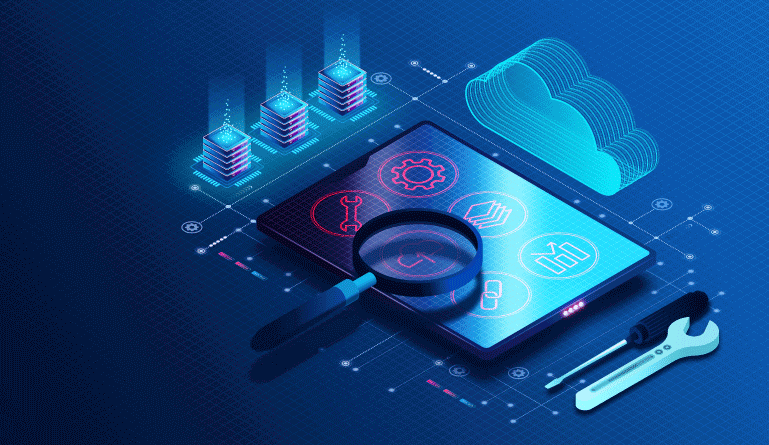DevOps and the cloud are being adopted by a growing number of organizations to improve their software solution capabilities.
Development and operations were once considered separate, but that mindset has changed. Connecting the two leads to enhanced collaboration, faster development timelines, and the capacity to always stay on top. IDC Technologies reports that using DevOps or the cloud separately accelerates software release by 50%. In comparison, collectively, there is an 81% acceleration.
Investing in a cloud+DevOps strategy may be a lot of effort, but it offers rich dividends for your organization. Let us explore how these key concepts can unite to power digital transformation.
Inside the Cloud and DevOps: How Do They Work?
DevOps is a multidisciplinary practice in which application development (dev) and IT operations (ops) work together to improve product performance and reduce time to market.
Developers and IT administrators work alongside specialists in quality control, security, and technical assistance within a DevOps framework. This collaborative process aims to swiftly deliver code in a continuous integration and continuous delivery (CI/CD) cycle.
DevOps builds upon the agile development methodologies of regular releases and CI/CD. It introduces infrastructure management to the equation, making product delivery more dynamic and flexible.
Although the cloud can be defined in many ways, its most fundamental definition is a system enabling off-site infrastructure provisioning. In turn, infrastructure can be described as code or templates, facilitating the development of unattainable iterative processes with on-premise servers.
When DevOps teams operate in the cloud, they can easily access extensible hardware resources, letting them develop, assess, and release new updates and products faster.
In a conventional delivery environment, the finished app can be transferred to the IT department for maintenance, with upgrades being maintained based on a predetermined schedule. However, the application architecture will evolve in cloud computing following its initial release. As a result, the organization can continuously enhance its services and products.
Examples of Cloud-based DevOps Tools
As organizations increasingly integrate these two technologies, cloud service providers create tools for this market. Here are a few examples of cloud-based applications that incorporate DevOps:
-
AWS CodeBuild
AWS CodeBuild is a fully managed cloud-based continuous integration (CI) service. The tool will assemble your source code, execute tests, and generate deployment-ready software packages.
The service manages infrastructure – and as a result, provisioning, scaling, and managing build servers aren’t necessary anymore. It is also highly expandable and can process multiple builds concurrently. Bitbucket, GitHub, GitHub EnterpriseAWS, Amazon S3, and CodeCommit are some of the source providers that CodeBuild supports. Additionally, it integrates with several open-source applications, like Spinnaker and Jenkins.
-
Google Cloud Monitoring
This service captures events, metadata, and metrics from various sources, like Google Cloud, Amazon Web Services, application instrumentation, etc. It can be used with the BindPlane observability service to gather data from over 150 app elements and systems. This data is ingested by Google Cloud’s operations application, which then generates findings as visualizations, notifications, and dashboards.
-
Azure Boards
Microsoft Azure offers modern DevOps teams with cloud-based services and tools. Boards is a cloud-based application that offers interactive and configurable software project management tools. It includes calendar viewers, native support for Scrum and Kanban, along with agile processes, comprehensive reporting, and configurable interfaces, among other features. You can use these capabilities to scale your project as it grows and develops.
5 Ways to Leverage DevOps Along with the Cloud
If you are looking for new ways to bring these powerful functions together, make sure to explore:
-
DevOps as a Service
DevOps-as-a-Service is an ensemble of cloud-based technologies that facilitate collaboration between a business’s development and operations divisions. The DevOps-as-a-Service vendor delivers a unified platform with a toolkit that includes every vital component of the DevOps process – for example, the Azure DevOps solution.
It is the antithesis of a “best of breed” toolchain, wherein teams choose their preferred tools based on each purpose. It simplifies DevOps implementation for companies unfamiliar with agile processes as it eliminates the need for training or the integration of several-point solutions.
-
Cloud, security, and operations or CloudSecOps
SecOps is a process that combines security and IT operations. The SecOps team includes qualified software architects and security analysts who can track emerging risks and safeguard assets. Cloud security operations (CloudSecOps) continue the SecOps function that aims to detect, react to, and remediate systems from attacks on a company’s cloud assets.
-
Serverless architecture for the DevOps pipeline
Instead of investing in equipment, serverless architecture can be used. This removes the need to purchase and maintain fixed infrastructure. You can use the cloud, which offers on-demand servers and computational power. This allows the DevOps team to transfer more projects to the cloud without spending too much on idle resources. Instead of having to expand your services in advance, the team now possesses the capacity to scale according to the project at hand.
-
Infrastructure as Code (IaC)
Infrastructure as Code (IaC) refers to providing and managing infrastructure with code instead of manually executed processes. With IaC, configuration files containing the actual infrastructure parameters are developed using software.
IaC tools such as Terraform, AWS CloudFormation, and Azure Resource Manager can be used by DevOps teams to set up and execute infrastructure in a repeatable and consistent manner. Imagine you are a DevOps engineer developing a web application. You just need to send your application to the cloud, and IaC can automate the deployment process.
-
Collaboration through ChatOps
ChatOps is a teamwork and collaboration tool that facilitates real-time interactions between DevOps teams via cloud-based messaging platforms like Slack and Microsoft Teams. ChatOps allows everyone to share data, work together on code, and quickly resolve issues. This strategy reduces organizational silos, enhances openness, and facilitates constant feedback and improvements.
Why Use DevOps+Cloud? Key Benefits
Whether partially or supported by a full-scale strategic plan, most DevOps teams rely on the cloud. This is because of the following benefits:
- Take advantage of ready-to-use tools: Many cloud service providers offer integrated DevOps services. This enables effective management of every aspect of the software lifecycle – as well as cloud resources – all from just one environment.
- Automate DevOps processes: With DevOps, you can automate repetitive tasks, thereby optimizing the software development process. Cloud platforms deliver automation tools for DevOps processes, such as continuous integration (CI).
- Scale up or down as needed: In a DevOps environment, infrastructure frequently needs to scale up or down to meet demands. This can be done rapidly using cloud services.
- Centralize DevOps processes: The cloud offers a centralized administrative hub to host all operations, including design, development, testing, implementation, and supervision. This facilitates the management and improvement of applications, security, and compliance.
- Save costs: Optimizing costs will become important as cloud service utilization keeps rising. By automating these processes, DevOps will help reduce your total cost of ownership, automating essential tasks like resource deprovisioning.
Key Takeaways
An organization that integrates DevOps with the cloud and vice versa will save costs, promote, speed up innovation, and empower its employees. Most companies will see both concepts used together, even if they have not planned for it. When DevOps teams try to benefit from the cloud without full strategic support, it can cause:
- Shadow IT and security risks
- The breakdown of team communication
- Silos from using different tools and environments
For these reasons, it is essential to seriously consider the cloud and DevOps as two complementary (even intertwined) concepts. With careful planning and informed investments, you can unlock vastly better application delivery outcomes by using the two together.
Download the whitepaper to know the best tools for your agile DevOps goals.





